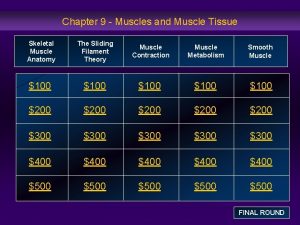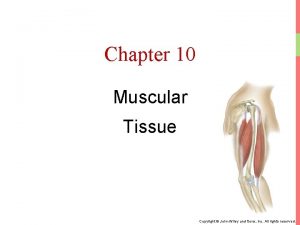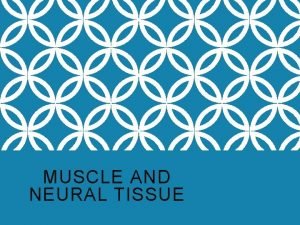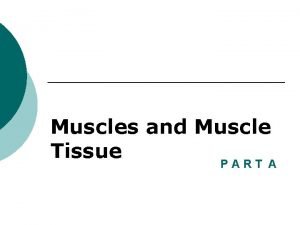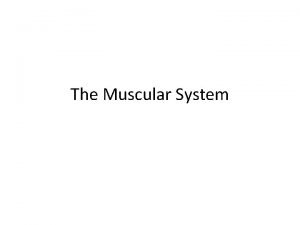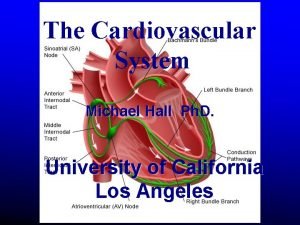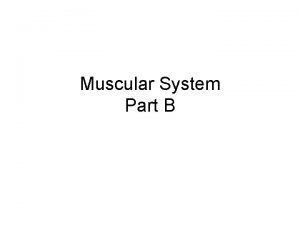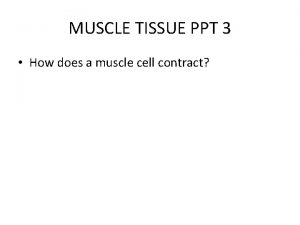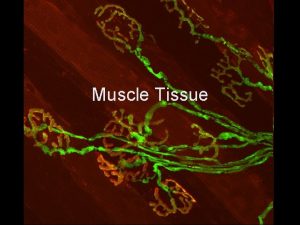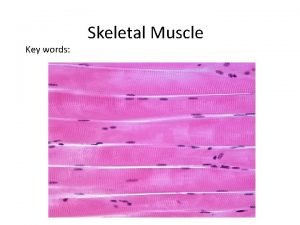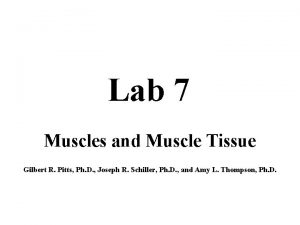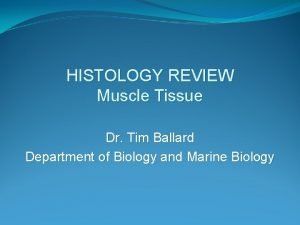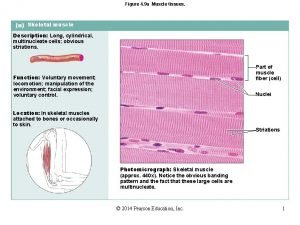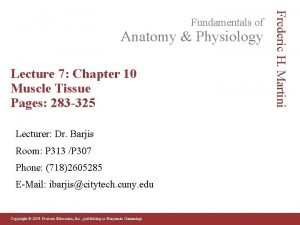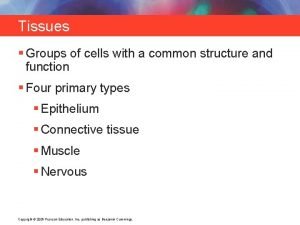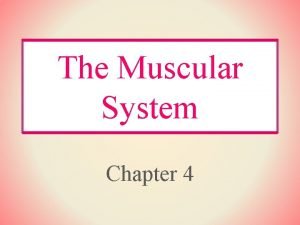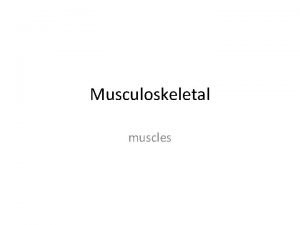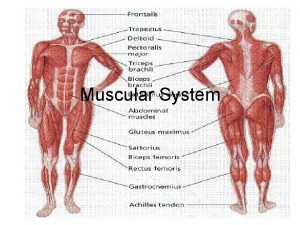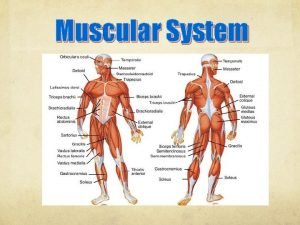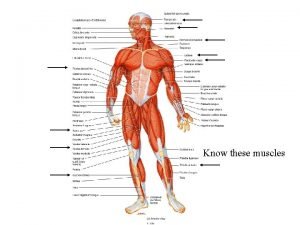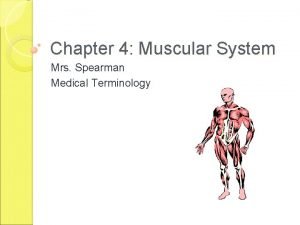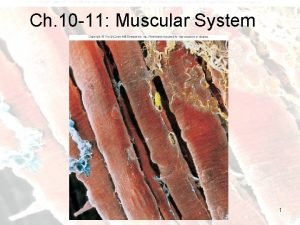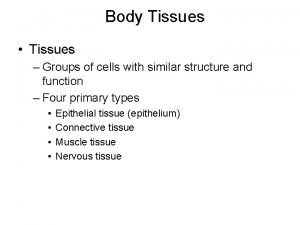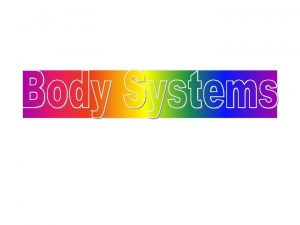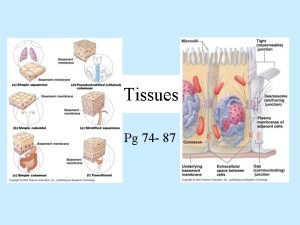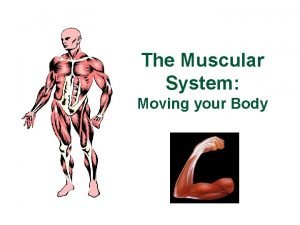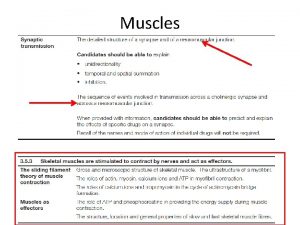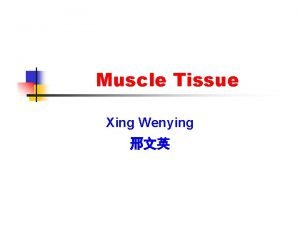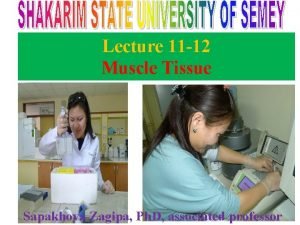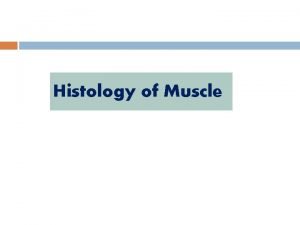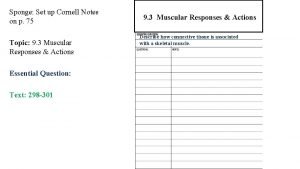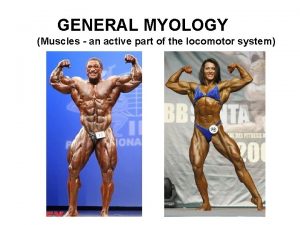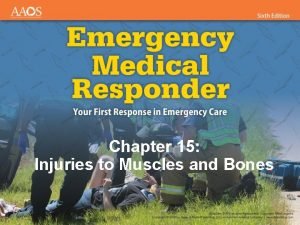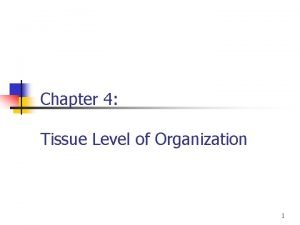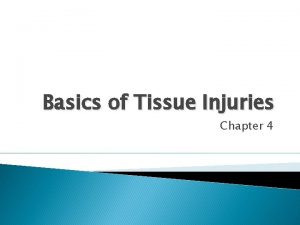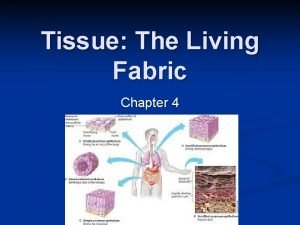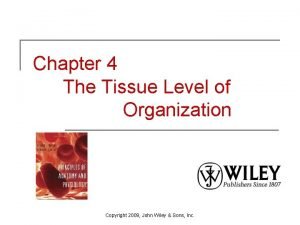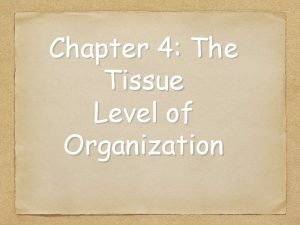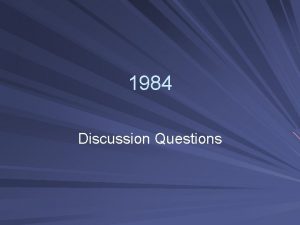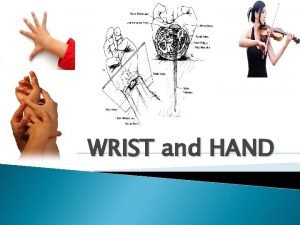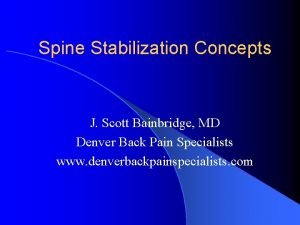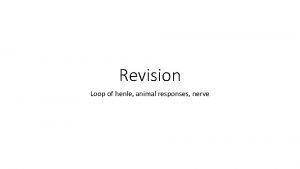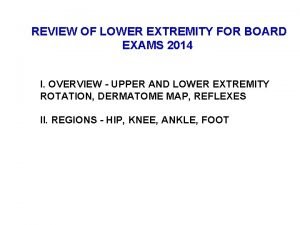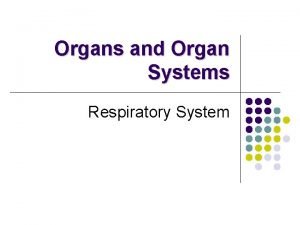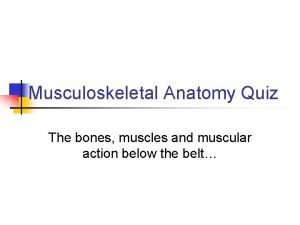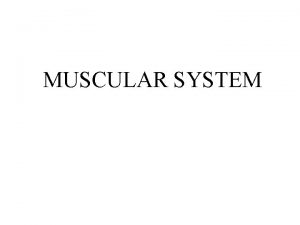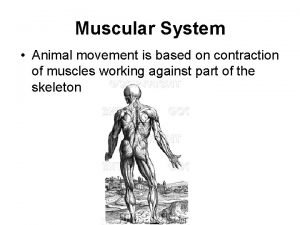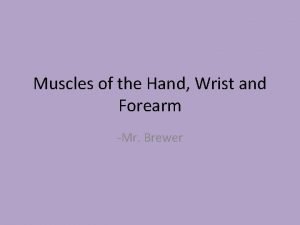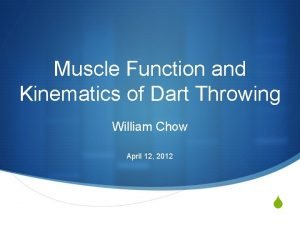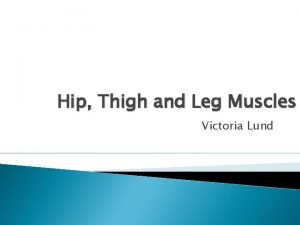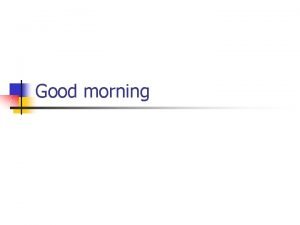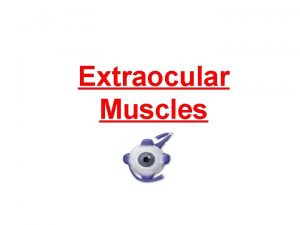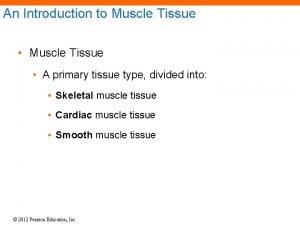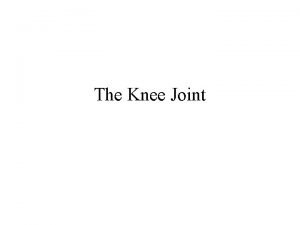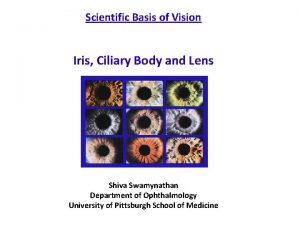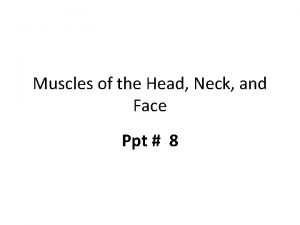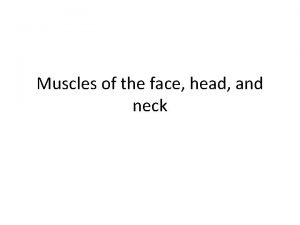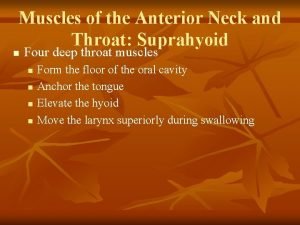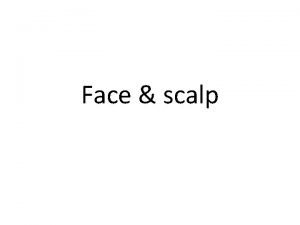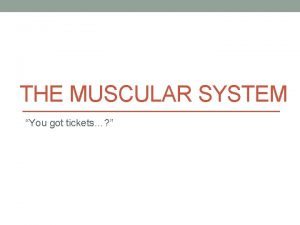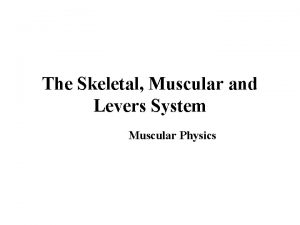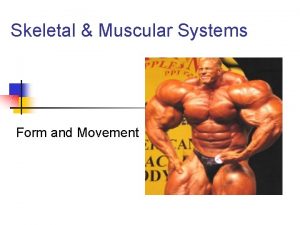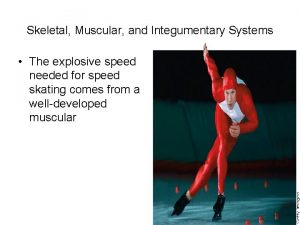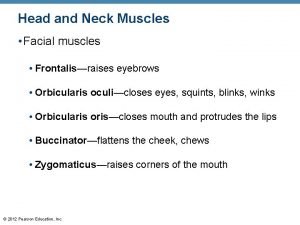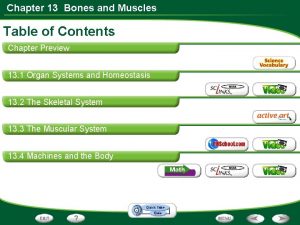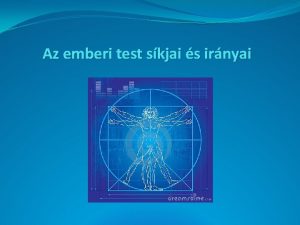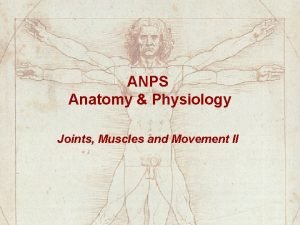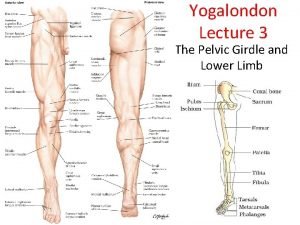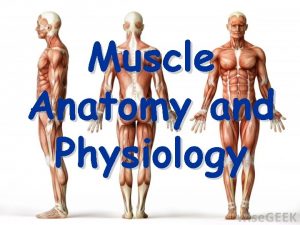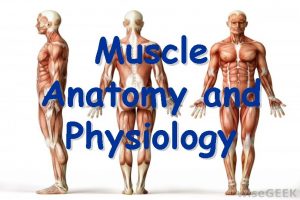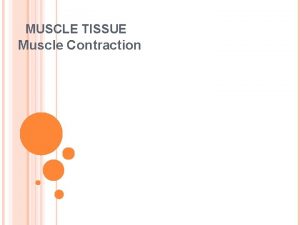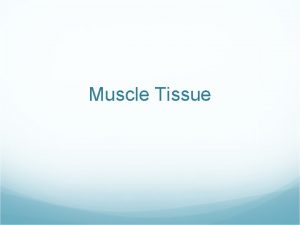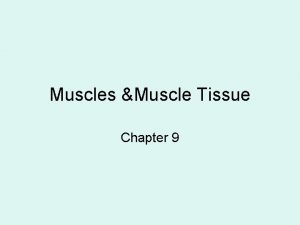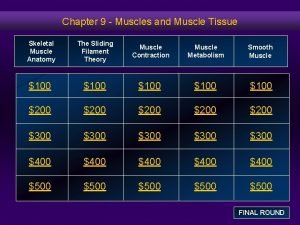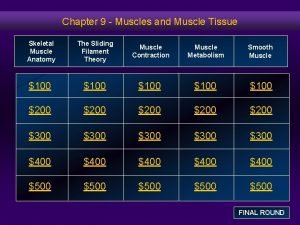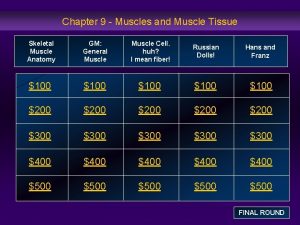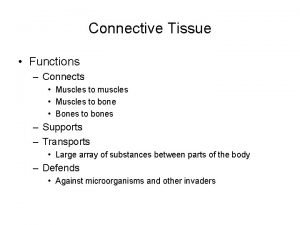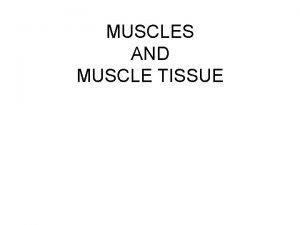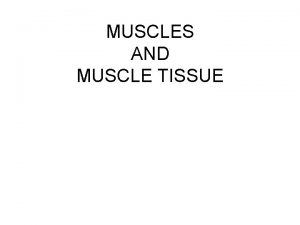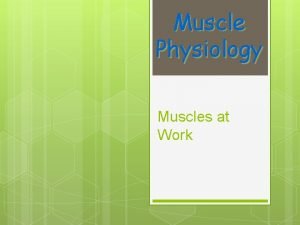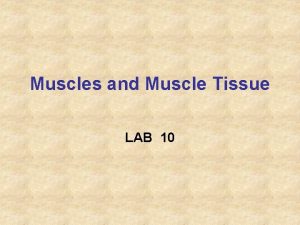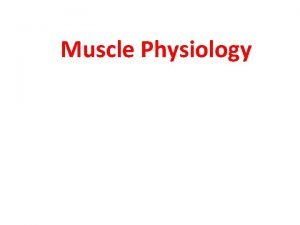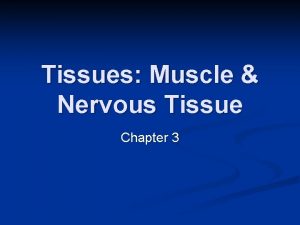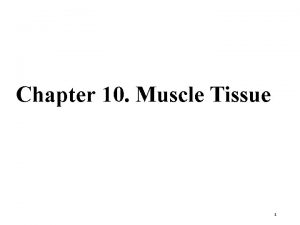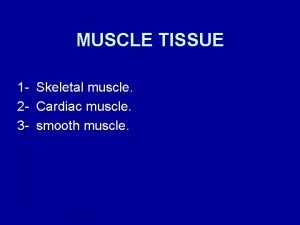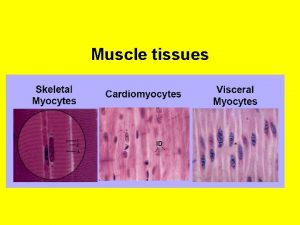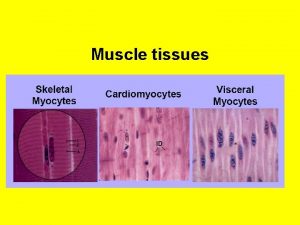Chapter 9 Part A Muscles and Muscle Tissue


















































































- Slides: 82

Chapter 9 Part A Muscles and Muscle Tissue © Annie Leibovitz/Contact Press Images © 2016 Pearson Education, Inc. Power. Point® Lecture Slides prepared by Karen Dunbar Kareiva Ivy Tech Community College

Why This Matters • Understanding skeletal muscle tissue helps you to treat strained muscles effectively with RICE © 2016 Pearson Education, Inc.

9. 1 Overview of Muscle Tissue • Nearly half of body’s mass • Can transform chemical energy (ATP) into directed mechanical energy, which is capable of exerting force • To investigate muscle, we look at: – Types of muscle tissue – Characteristics of muscle tissue – Muscle functions © 2016 Pearson Education, Inc.

Types of Muscle Tissue • Terminologies: Myo, mys, and sarco are prefixes for muscle – Example: sarcoplasm: muscle cell cytoplasm • Three types of muscle tissue – Skeletal – Cardiac – Smooth • Only skeletal and smooth muscle cells are elongated and referred to as muscle fibers © 2016 Pearson Education, Inc.

Types of Muscle Tissue (cont. ) • Skeletal muscle – Skeletal muscle tissue is packaged into skeletal muscles: organs that are attached to bones and skin – Skeletal muscle fibers are longest of all muscle and have striations (stripes) – Also called voluntary muscle: can be consciously controlled – Contract rapidly; tire easily; powerful – Key words for skeletal muscle: skeletal, striated, and voluntary © 2016 Pearson Education, Inc.

Types of Muscle Tissue (cont. ) • Cardiac muscle – Cardiac muscle tissue is found only in heart • Makes up bulk of heart walls – Striated – Involuntary: cannot be controlled consciously • Contracts at steady rate due to heart’s own pacemaker, but nervous system can increase rate – Key words for cardiac muscle: cardiac, striated, and involuntary © 2016 Pearson Education, Inc.

Types of Muscle Tissue (cont. ) • Smooth muscle – Smooth muscle tissue: found in walls of hollow organs • Examples: stomach, urinary bladder, and airways – Not striated – Involuntary: cannot be controlled consciously • Can contract on its own without nervous system stimulation © 2016 Pearson Education, Inc.

Table 9. 3 -1 Comparison of Skeletal, Cardiac, and Smooth Muscle © 2016 Pearson Education, Inc.

Characteristics of Muscle Tissue • All muscles share four main characteristics: – Excitability (responsiveness): ability to receive and respond to stimuli – Contractility: ability to shorten forcibly when stimulated – Extensibility: ability to be stretched – Elasticity: ability to recoil to resting length © 2016 Pearson Education, Inc.

Muscle Functions • Four important functions 1. Produce movement: responsible for all locomotion and manipulation • Example: walking, digesting, pumping blood 2. Maintain posture and body position 3. Stabilize joints 4. Generate heat as they contract • Additional functions – Protect organs, form valves, control pupil size, cause “goosebumps” © 2016 Pearson Education, Inc.

9. 2 Skeletal Muscle Anatomy • Skeletal muscle is an organ made up of different tissues with three features: nerve and blood supply, connective tissue sheaths, and attachments © 2016 Pearson Education, Inc.

Nerve and Blood Supply • Each muscle receives a nerve, artery, and veins – Consciously controlled skeletal muscle has nerves supplying every fiber to control activity • Contracting muscle fibers require huge amounts of oxygen and nutrients – Also need waste products removed quickly © 2016 Pearson Education, Inc.

Connective Tissue Sheaths • Each skeletal muscle, as well as each muscle fiber, is covered in connective tissue • Support cells and reinforce whole muscle • Sheaths from external to internal: – Epimysium: dense irregular connective tissue surrounding entire muscle; may blend with fascia – Perimysium: fibrous connective tissue surrounding fascicles (groups of muscle fibers) – Endomysium: fine areolar connective tissue surrounding each muscle fiber © 2016 Pearson Education, Inc.

Figure 9. 1 Connective tissue sheaths of skeletal muscle: epimysium, perimysium, and endomysium. Bone Epimysium Perimysium Tendon Endomysium Muscle fiber in middle of a fascicle Blood vessel Perimysium wrapping a fascicle Endomysium (between individual muscle fibers) Muscle fiber Fascicle Perimysium © 2016 Pearson Education, Inc.

Attachments • Muscles span joints and attach to bones • Muscles attach to bone in at least two places – Insertion: attachment to movable bone – Origin: attachment to immovable or less movable bone • Attachments can be direct or indirect – Direct (fleshy): epimysium fused to periosteum of bone or perichondrium of cartilage – Indirect: connective tissue wrappings extend beyond muscle as ropelike tendon or sheetlike aponeurosis © 2016 Pearson Education, Inc.

Figure 9. 1 a Connective tissue sheaths of skeletal muscle: epimysium, perimysium, and endomysium. Bone Epimysium Tendon Blood vessel Perimysium wrapping a fascicle Endomysium (between individual muscle fibers) Muscle fiber Fascicle Perimysium © 2016 Pearson Education, Inc.

Table 9. 1 -1 Structure and Organizational Levels of Skeletal Muscle © 2016 Pearson Education, Inc.

9. 3 Muscle Fiber Microanatomy and Sliding Filament Model • Skeletal muscle fibers are long, cylindrical cells that contain multiple nuclei • Sarcolemma: muscle fiber plasma membrane • Sarcoplasm: muscle fiber cytoplasm • Contains many glycosomes for glycogen storage, as well as myoglobin for O 2 storage • Modified organelles – Myofibrils – Sarcoplasmic reticulum – T tubules © 2016 Pearson Education, Inc.

Myofibrils • Myofibrils are densely packed, rodlike elements – Single muscle fiber can contain 1000 s – Accounts for ~80% of muscle cell volume • Myofibril features – Striations – Sarcomeres – Myofilaments – Molecular composition of myofilaments © 2016 Pearson Education, Inc.

Figure 9. 2 b Microscopic anatomy of a skeletal muscle fiber. Diagram of part of a muscle fiber showing the myofibrils. One myofibril extends from the cut end of the fiber. Sarcolemma Mitochondrion Dark A band © 2016 Pearson Education, Inc. Light I band Nucleus Myofibril

Myofibrils (cont. ) • Striations: stripes formed from repeating series of dark and light bands along length of each myofibril – A bands: dark regions • H zone: lighter region in middle of dark A band – M line: line of protein (myomesin) that bisects H zone vertically – I bands: lighter regions • Z disc (line): coin-shaped sheet of proteins on midline of light I band © 2016 Pearson Education, Inc.

Figure 9. 2 a Microscopic anatomy of a skeletal muscle fiber. Photomicrograph of portions of two isolated muscle fibers (700×). Notice the obvious striations (alternating dark and light bands). Nuclei Dark A band Light I band Fiber © 2016 Pearson Education, Inc.

Myofibrils (cont. ) • Sarcomere – Smallest contractile unit (functional unit) of muscle fiber – Contains A band with half of an I band at each end • Consists of area between Z discs – Individual sarcomeres align end to end along myofibril, like boxcars of train © 2016 Pearson Education, Inc.

Figure 9. 2 c Microscopic anatomy of a skeletal muscle fiber. Thin (actin) filament Small part of one myofibril enlarged to show the myofilaments responsible for the banding pattern. Each sarcomere extends from one Z disc to the next. © 2016 Pearson Education, Inc. Z disc Thick (myosin) I band filament H zone A band Sarcomere Z disc I band M line

Myofibrils (cont. ) • Myofilaments – Orderly arrangement of actin and myosin myofilaments within sarcomere – Actin myofilaments: thin filaments • Extend across I band partway in A band • Anchored to Z discs – Myosin myofilaments: thick filaments • Extend length of A band • Connected at M line – Sarcomere cross section shows hexagonal arrangement of one thick filament surrounded by six thin filaments © 2016 Pearson Education, Inc.

Figure 9. 2 de Microscopic anatomy of a skeletal muscle fiber. Z disc Sarcomere M line Z disc Enlargement of one sarcomere (sectioned lengthwise). Notice the myosin heads on the thick filaments. Thin (actin) filament Elastic (titin) filaments Thick (myosin) filament Cross-sectional view of a sarcomere cut through in different locations. Myosin filament Actin filament I band thin filaments only © 2016 Pearson Education, Inc. H zone thick filaments only M line Outer edge of A band thick filaments linked by thick and thin accessory filaments overlap proteins

Myofibrils (cont. ) • Molecular composition of myofilaments – Thick filaments: composed of protein myosin that contains two heavy and four light polypeptide chains • Heavy chains intertwine to form myosin tail • Light chains form myosin globular head – During contraction, heads link thick and thin filaments together, forming cross bridges • Myosins are offset from each other, resulting in staggered array of heads at different points along thick filament © 2016 Pearson Education, Inc.

Myofibrils (cont. ) • Molecular composition of myofilaments (cont. ) – Thin filaments: composed of fibrous protein actin • Actin is polypeptide made up of kidney-shaped G actin (globular) subunits – G actin subunits bears active sites for myosin head attachment during contraction • G actin subunits link together to form long, fibrous F actin (filamentous) • Two F actin strands twist together to form a thin filament – Tropomyosin and troponin: regulatory proteins bound to actin © 2016 Pearson Education, Inc.

Figure 9. 3 -2 Composition of thick and thin filaments. Thick filament Each thick filament consists of many myosin molecules whose heads protrude at opposite ends of the filament. Portion of a thick filament Myosin head Actin-binding sites Heads Tail ATPbinding site Flexible hinge region Myosin molecule © 2016 Pearson Education, Inc.

Figure 9. 3 -3 Composition of thick and thin filaments. Thin filament A thin filament consists of two strands of actin subunits twisted into a helix plus two types of regulatory proteins (troponin and tropomyosin). Portion of a thin filament Tropomyosin Troponin Active sites for myosin attachment Actin subunits © 2016 Pearson Education, Inc.

Figure 9. 4 Myosin heads forming cross bridges that generate muscular contractile force. Thin filament (actin) © 2016 Pearson Education, Inc. Myosin heads Thick filament (myosin)

Myofibrils (cont. ) • Molecular composition of myofilaments (cont. ) – Other proteins help form the structure of the myofibril • Elastic filament: composed of protein titin – Holds thick filaments in place; helps recoil after stretch; resists excessive stretching • Dystrophin – Links thin filaments to proteins of sarcolemma • Nebulin, myomesin, C proteins bind filaments or sarcomeres together – Maintain alignment of sarcomere © 2016 Pearson Education, Inc.

Sarcoplasmic Reticulum and T Tubules • Sarcoplasmic reticulum: network of smooth endoplasmic reticulum tubules surrounding each myofibril – Most run longitudinally – Terminal cisterns form perpendicular cross channels at the A–I band junction – SR functions in regulation of intracellular Ca 2+ levels – Stores and releases Ca 2+ © 2016 Pearson Education, Inc.

Sarcoplasmic Reticulum and T Tubules (cont. ) • T tubules – Tube formed by protrusion of sarcolemma deep into cell interior • Increase muscle fiber’s surface area greatly • Lumen continuous with extracellular space • Allow electrical nerve transmissions to reach deep into interior of each muscle fiber – Tubules penetrate cell’s interior at each A–I band junction between terminal cisterns • Triad: area formed from terminal cistern of one sarcomere, T tubule, and terminal cistern of neighboring sarcomere © 2016 Pearson Education, Inc.

Sarcoplasmic Reticulum and T Tubules (cont. ) • Triad relationships – T tubule contains integral membrane proteins that protrude into intermembrane space (space between tubule and muscle fiber sarcolemma) • Tubule proteins act as voltage sensors that change shape in response to an electrical current – SR cistern membranes also have integral membrane proteins that protrude into intermembrane space • SR integral proteins control opening of calcium channels in SR cisterns © 2016 Pearson Education, Inc.

Sarcoplasmic Reticulum and T Tubules (cont. ) • Triad relationships (cont. ) – When an electrical impulse passes by, T tubule proteins change shape, causing SR proteins to change shape, causing release of calcium into cytoplasm © 2016 Pearson Education, Inc.

Figure 9. 5 Relationship of the sarcoplasmic reticulum and T tubules to myofibrils of skeletal muscle. Part of a skeletal muscle fiber (cell) I band A band I band Z disc H zone Z disc M line Myofibril Sarcolemma Triad: • T tubule • Terminal cisterns of the SR (2) Tubules of the SR Myofibrils Mitochondria © 2016 Pearson Education, Inc.

Sliding Filament Model of Contraction • Contraction: the activation of cross bridges to generate force • Shortening occurs when tension generated by cross bridges on thin filaments exceeds forces opposing shortening • Contraction ends when cross bridges become inactive © 2016 Pearson Education, Inc.

Sliding Filament Model of Contraction (cont. ) • In the relaxed state, thin and thick filaments overlap only slightly at ends of A band • Sliding filament model of contraction states that during contraction, thin filaments slide past thick filaments, causing actin and myosin to overlap more – Neither thick nor thin filaments change length, just overlap more • When nervous system stimulates muscle fiber, myosin heads are allowed to bind to actin, forming cross bridges, which cause sliding (contraction) process to begin © 2016 Pearson Education, Inc.

Sliding Filament Model of Contraction (cont. ) • Cross bridge attachments form and break several times, each time pulling thin filaments a little closer toward center of sarcome in a ratcheting action – Causes shortening of muscle fiber • • • Z discs are pulled toward M line I bands shorten Z discs become closer H zones disappear A bands move closer to each other © 2016 Pearson Education, Inc.

Figure 9. 6 -1 Sliding filament model of contraction. 1 Fully relaxed sarcomere of a muscle fiber Z l © 2016 Pearson Education, Inc. H A Z l

Figure 9. 6 -2 Sliding filament model of contraction. 2 Fully contracted sarcomere of a muscle fiber Z l © 2016 Pearson Education, Inc. A Z l

9. 4 Muscle Fiber Contraction • Four steps must occur for skeletal muscle to contract: 1. Nerve stimulation 2. Action potential, an electrical current, must be generated in sarcolemma 3. Action potential must be propagated along sarcolemma 4. Intracellular Ca 2+ levels must rise briefly • Steps 1 and 2 occur at neuromuscular junction • Steps 3 and 4 link electrical signals to contraction, so referred to as excitation-contraction coupling © 2016 Pearson Education, Inc.

Figure 9. 7 The phases leading to muscle fiber contraction. Action potential (AP) arrives at axon terminal at neuromuscular junction ACh released; binds to receptors on sarcolemma Phase 1: Motor neuron stimulates muscle fiber (see Focus Figure 9. 1). Ion permeability of sarcolemma changes Local change in membrane voltage (depolarization) occurs Local depolarization (end plate potential) ignites AP in sarcolemma AP travels across the entire sarcolemma AP travels along T tubules Phase 2: Excitation-contraction coupling occurs (see Figure 9. 8 and Focus Figure 9. 2). SR releases Ca 2+; Ca 2+ binds to troponin; myosin-binding sites (active sites) on actin exposed Myosin heads bind to actin; contraction begins © 2016 Pearson Education, Inc.

The Nerve Stimulus and Events at the Neuromuscular Junction • Skeletal muscles are stimulated by somatic motor neurons • Axons (long, threadlike extensions of motor neurons) travel from central nervous system to skeletal muscle • Each axon divides into many branches as it enters muscle • Axon branches end on muscle fiber, forming neuromuscular junction or motor end plate – Each muscle fiber has one neuromuscular junction with one motor neuron © 2016 Pearson Education, Inc.

Slide 2 Focus Figure 9. 1 When a nerve impulse reaches a neuromuscular junction, acetylcholine (ACh) is released. Myelinated axon of motor neuron Axon terminal of neuromuscular junction Action potential (AP) Sarcolemma of the muscle fiber 1 Action potential arrives at axon terminal of motor neuron. Ca 2+ Axon terminal of motor neuron Fusing synaptic vesicles ACh © 2016 Pearson Education, Inc.

Slide 3 Focus Figure 9. 1 When a nerve impulse reaches a neuromuscular junction, acetylcholine (ACh) is released. Myelinated axon of motor neuron Axon terminal of neuromuscular junction Action potential (AP) Sarcolemma of the muscle fiber 1 Action potential arrives at axon terminal of motor neuron. 2 Voltage-gated Ca 2+ channels open. Ca 2+ enters the axon terminal, moving down its electrochemical gradient. Ca 2+ Axon terminal of motor neuron Fusing synaptic vesicles ACh Synaptic vesicle containing ACh Synaptic cleft Junctional folds of sarcolemma Sarcoplasm of muscle fiber © 2016 Pearson Education, Inc.

Slide 4 Focus Figure 9. 1 When a nerve impulse reaches a neuromuscular junction, acetylcholine (ACh) is released. Myelinated axon of motor neuron Axon terminal of neuromuscular junction Action potential (AP) Sarcolemma of the muscle fiber 1 Action potential arrives at axon terminal of motor neuron. 2 Voltage-gated Ca 2+ channels open. Ca 2+ enters the axon terminal, moving down its electrochemical gradient. 3 Ca 2+ entry causes ACh (a neurotransmitter) to be released by exocytosis. Ca 2+ Axon terminal of motor neuron Fusing synaptic vesicles ACh Synaptic vesicle containing ACh Synaptic cleft Junctional folds of sarcolemma Sarcoplasm of muscle fiber © 2016 Pearson Education, Inc.

The Nerve Stimulus and Events at the Neuromuscular Junction (cont. ) • Axon terminal (end of axon) and muscle fiber are separated by gel-filled space called synaptic cleft • Stored within axon terminals are membranebound synaptic vesicles – Synaptic vesicles contain neurotransmitter acetylcholine (ACh) • Infoldings of sarcolemma, called junctional folds, contain millions of ACh receptors • NMJ consists of axon terminals, synaptic cleft, and junctional folds © 2016 Pearson Education, Inc.

Slide 5 Focus Figure 9. 1 When a nerve impulse reaches a neuromuscular junction, acetylcholine (ACh) is released. Myelinated axon of motor neuron Axon terminal of neuromuscular junction Action potential (AP) Sarcolemma of the muscle fiber 1 Action potential arrives at axon terminal of motor neuron. 2 Voltage-gated Ca 2+ channels open. Ca 2+ enters the axon terminal, moving down its electrochemical gradient. 3 Ca 2+ entry causes ACh (a neurotransmitter) to be released by exocytosis. 4 ACh diffuses across the synaptic cleft and binds to its receptors on the sarcolemma. © 2016 Pearson Education, Inc. Ca 2+ Axon terminal of motor neuron Fusing synaptic vesicles ACh Synaptic vesicle containing ACh Synaptic cleft Junctional folds of sarcolemma Sarcoplasm of muscle fiber

Slide 6 Focus Figure 9. 1 When a nerve impulse reaches a neuromuscular junction, acetylcholine (ACh) is released. Myelinated axon of motor neuron Axon terminal of neuromuscular junction Action potential (AP) Sarcolemma of the muscle fiber 1 Action potential arrives at axon terminal of motor neuron. 2 Voltage-gated Ca 2+ channels open. Ca 2+ enters the axon terminal, moving down its electrochemical gradient. 3 Ca 2+ entry causes ACh (a neurotransmitter) to be released by exocytosis. Ca 2+ Axon terminal of motor neuron Fusing synaptic vesicles ACh 4 ACh diffuses across the synaptic cleft and binds to its receptors on the sarcolemma. 5 ACh binding opens ion channels in the receptors that allow simultaneous passage of Na + into the muscle fiber and K+ out of the muscle fiber. More Na+ ions enter than K+ ions exit, which produces a local change in the membrane potential called the end plate potential. © 2016 Pearson Education, Inc. Synaptic vesicle containing ACh Synaptic cleft Junctional folds of sarcolemma Sarcoplasm of muscle fiber Na+ K+ Postsynaptic membrane ion channel opens; ions pass.

The Nerve Stimulus and Events at the Neuromuscular Junction (cont. ) • Events at the neuromuscular junction – Nerve impulse arrives at axon terminal, causing ACh to be released into synaptic cleft – ACh diffuses across cleft and binds with receptors on sarcolemma – ACh binding leads to electrical events that ultimately generate an action potential through muscle fiber – ACh is quickly broken down by enzyme acetylcholinesterase, which stops contractions © 2016 Pearson Education, Inc.

Slide 7 Focus Figure 9. 1 When a nerve impulse reaches a neuromuscular junction, acetylcholine (ACh) is released. Myelinated axon of motor neuron Axon terminal of neuromuscular junction Action potential (AP) Sarcolemma of the muscle fiber 1 Action potential arrives at axon terminal of motor neuron. 2 Voltage-gated Ca 2+ channels open. Ca 2+ enters the axon terminal, moving down its electrochemical gradient. Ca 2+ Axon terminal of motor neuron Fusing synaptic vesicles 3 Ca 2+ entry causes ACh (a neurotransmitter) to be released by exocytosis. ACh 4 ACh diffuses across the synaptic cleft and binds to its receptors on the sarcolemma. © 2016 Pearson Education, Inc. Junctional folds of sarcolemma Sarcoplasm of muscle fiber 5 ACh binding opens ion channels in the receptors that allow simultaneous passage of Na + into the muscle fiber and K+ out of the muscle fiber. More Na+ ions enter than K+ ions exit, which produces a local change in the membrane potential called the end plate potential. 6 ACh effects are terminated by its breakdown in the synaptic cleft by acetylcholinesterase and diffusion away from the junction. Synaptic vesicle containing ACh Synaptic cleft Na+ K+ ACh Degraded ACh Na+ Acetylcholinesterase K+ Postsynaptic membrane ion channel opens; ions pass. Ion channel closes; ions cannot pass.

Clinical – Homeostatic Imbalance 9. 1 • Many toxins, drugs, and diseases interfere with events at the neuromuscular junction – Example: myasthenia gravis: disease characterized by drooping upper eyelids, difficulty swallowing and talking, and generalized muscle weakness – Involves shortage of Ach receptors because person’s ACh receptors are attacked by own antibodies – Suggests this is an autoimmune disease © 2016 Pearson Education, Inc.

Generation of an Action Potential Across the Sarcolemma • Resting sarcolemma is polarized, meaning a voltage exists across membrane – Inside of cell is negative compared to outside • Action potential is caused by changes in electrical charges • Occurs in three steps 1. End plate potential 2. Depolarization 3. Repolarization © 2016 Pearson Education, Inc.

Generation of an Action Potential Across the Sarcolemma (cont. ) 1. End plate potential – ACh released from motor neuron binds to ACh receptors on sarcolemma – Causes chemically gated ion channels (ligands) on sarcolemma to open – Na+ diffuses into muscle fiber • Some K+ diffuses outward, but not much – Because Na+ diffuses in, interior of sarcolemma becomes less negative (more positive) – Results in local depolarization called end plate potential © 2016 Pearson Education, Inc.

Figure 9. 8 Summary of events in the generation and propagation of an action potential in a skeletal muscle fiber. ACh-containing synaptic vesicle Ca 2+ Synaptic cleft Ca 2+ Axon terminal of neuromuscular junction Wave of depolarization 1 An end plate potential is generated at the neuromuscular junction (see Focus Figure 9. 1). © 2016 Pearson Education, Inc. Slide 2

Generation of an Action Potential Across the Sarcolemma (cont. ) 2. Depolarization: generation and propagation of an action potential (AP) – If end plate potential causes enough change in membrane voltage to reach critical level called threshold, voltage-gated Na+ channels in membrane will open – Large influx of Na+ through channels into cell triggers AP that is unstoppable and will lead to muscle fiber contraction – AP spreads across sarcolemma from one voltage -gated Na+ channel to next one in adjacent areas, causing that area to depolarize © 2016 Pearson Education, Inc.

Slide 3 Figure 9. 8 Summary of events in the generation and propagation of an action potential in a skeletal muscle fiber. ACh-containing synaptic vesicle Ca 2+ Synaptic cleft Ca 2+ Axon terminal of neuromuscular junction Open Na+ channel Na+ Closed K+ channel K+ Action potential Wave of depolarization 1 An end plate potential is generated at the neuromuscular junction (see Focus Figure 9. 1). © 2016 Pearson Education, Inc. 2 Depolarization: Generating and propagating an action potential.

Generation of an Action Potential Across the Sarcolemma (cont. ) 3. Repolarization: restoration of resting conditions – Na+ voltage-gated channels close, and voltagegated K+ channels open – K+ efflux out of cell rapidly brings cell back to initial resting membrane voltage – Refractory period: muscle fiber cannot be stimulated for a specific amount of time, until repolarization is complete – Ionic conditions of resting state are restored by Na+-K+ pump • Na+ that came into cell is pumped back out, and K+ that flowed outside is pumped back into cell © 2016 Pearson Education, Inc.

Slide 4 Figure 9. 8 Summary of events in the generation and propagation of an action potential in a skeletal muscle fiber. ACh-containing synaptic vesicle Ca 2+ Synaptic cleft Ca 2+ Axon terminal of neuromuscular junction Closed K+ channel Open Na+ channel Na+ K+ Action potential Wave of depolarization 1 An end plate potential is generated at the neuromuscular junction (see Focus Figure 9. 1). 2 Depolarization: Generating and propagating an action potential. Closed Na+ channel Open K+ channel Na+ K+ 3 Repolarization: Restoring the sarcolemma to its initial polarized state (negative inside, positive outside). © 2016 Pearson Education, Inc.

Membrane potential (m. V) Figure 9. 9 Action potential tracing indicates changes in Na+ and K+ ion channels. +30 0 Na+ channels close, K+ channels open Depolarization due to Na+ entry Repolarization due to K+ exit Na+ channels open K+ channels closed -90 0 © 2016 Pearson Education, Inc. 5 10 Time (ms) 15 20

Excitation-Contraction (E-C) Coupling • Excitation-contraction (E-C) coupling: events that transmit AP along sarcolemma (excitation) are coupled to sliding of myofilaments (contraction) • AP is propagated along sarcolemma and down into T tubules, where voltage-sensitive proteins in tubules stimulate Ca 2+ release from SR – Ca 2+ release leads to contraction • AP is brief and ends before contraction is seen © 2016 Pearson Education, Inc.

Focus Figure 9. 2 Excitation-contraction (E-C) coupling is the sequence of events by which transmission of an action potential along the sarcolemma leads to the sliding of myofilaments. Steps in E-C Coupling: Sarcolemma Voltage-sensitive tubule protein Setting the stage The events at the neuromuscular junction (NMJ) set the stage for E-C coupling by providing excitation. Released acetylcholine binds to receptor proteins on the sarcolemma and triggers an action potential in a muscle fiber. T tubule Action potential is generated Ca 2+ ACh Actin Sarcolemma Troponin T tubule Muscle fiber 2 Calcium ions are released. Transmission of the AP along the T tubules of the triads causes the voltage-sensitive tubule proteins to change shape. This shape change opens the Ca 2+ release channels in the terminal cisterns of the sarcoplasmic reticulum (SR), allowing Ca 2+ to flow into the cytosol. C a 2 + r e l e a s e c h a n Terminal n e l cistern of SR Axon terminal of motor neuron at NMJ Synaptic cleft Terminal cistern of SR Ca 2+ 1 The action potential (AP) propagates along the sarcolemma and down the T tubules. Tropomyosin blocking active sites Myosin Ca 2+ Triad Active sites exposed and ready for myosin binding 3 Calcium binds to troponin and removes the blocking action of tropomyosin. When Ca 2+ binds, troponin changes shape, exposing binding sites for myosin (active sites) on the thin filaments. One sarcomere One myofibril Myosin cross bridge 4 Contraction begins: Myosin binding to actin forms cross bridges and contraction (cross bridge cycling) begins. At this point, E-C coupling is over. The aftermath When the muscle AP ceases, the voltage-sensitive tubule proteins return to their original shape, closing the Ca 2+ release channels of the SR. Ca 2+ levels in the sarcoplasm fall as Ca 2+ is continually pumped back into the SR by active transport. Without Ca 2+, the blocking action of tropomyosin is restored, myosin-actin interaction is inhibited, and relaxation occurs. Each time an AP arrives at the neuromuscular junction, the sequence of E-C coupling is repeated. © 2016 Pearson Education, Inc.

Focus Figure 9. 2 Excitation-contraction (E-C) coupling is the sequence of events by which transmission of an action potential along the sarcolemma leads to the sliding of myofilaments. Steps in E-C Coupling: Sarcolemma Voltage-sensitive tubule protein T tubule Ca 2+ release channel Terminal cistern of SR Ca 2+ © 2016 Pearson Education, Inc. 1 The action potential (AP) propagates along the sarcolemma and down the T tubules. Slide 2

Focus Figure 9. 2 Excitation-contraction (E-C) coupling is the sequence of events by which transmission of an action potential along the sarcolemma leads to the sliding of myofilaments. Steps in E-C Coupling: Sarcolemma Voltage-sensitive tubule protein T tubule Ca 2+ release channel Terminal cistern of SR Ca 2+ © 2016 Pearson Education, Inc. 1 The action potential (AP) propagates along the sarcolemma and down the T tubules. 2 Calcium ions are released. Transmission of the AP along the T tubules of the triads causes the voltage-sensitive tubule proteins to change shape. This shape change opens the Ca 2+ release channels in the terminal cisterns of the sarcoplasmic reticulum (SR), allowing Ca 2+ to flow into the cytosol. Slide 3

Channels Involved in Initiating Muscle Contraction • Nerve impulse travels down axon of motor neuron • When impulse reaches axon terminal, voltagegated calcium channels open, and Ca 2+ enters axon terminal • Ca 2+ influx causes synaptic vesicle to exocytose Ach into synaptic cleft • ACh binds to receptors on sarcolemma, causing chemically gated Na+-K+ channels to open and initiate an end plate potential • When threshold is reached, voltage-gated Na+ channels open, initiating an AP © 2016 Pearson Education, Inc.

Slide 2 Focus Figure 9. 1 When a nerve impulse reaches a neuromuscular junction, acetylcholine (ACh) is released. Myelinated axon of motor neuron Axon terminal of neuromuscular junction Action potential (AP) Sarcolemma of the muscle fiber 1 Action potential arrives at axon terminal of motor neuron. Ca 2+ Axon terminal of motor neuron Fusing synaptic vesicles ACh © 2016 Pearson Education, Inc.

Slide 3 Focus Figure 9. 1 When a nerve impulse reaches a neuromuscular junction, acetylcholine (ACh) is released. Myelinated axon of motor neuron Axon terminal of neuromuscular junction Action potential (AP) Sarcolemma of the muscle fiber 1 Action potential arrives at axon terminal of motor neuron. 2 Voltage-gated Ca 2+ channels open. Ca 2+ enters the axon terminal, moving down its electrochemical gradient. Ca 2+ Axon terminal of motor neuron Fusing synaptic vesicles ACh Synaptic vesicle containing ACh Synaptic cleft Junctional folds of sarcolemma Sarcoplasm of muscle fiber © 2016 Pearson Education, Inc.

Slide 4 Focus Figure 9. 1 When a nerve impulse reaches a neuromuscular junction, acetylcholine (ACh) is released. Myelinated axon of motor neuron Axon terminal of neuromuscular junction Action potential (AP) Sarcolemma of the muscle fiber 1 Action potential arrives at axon terminal of motor neuron. 2 Voltage-gated Ca 2+ channels open. Ca 2+ enters the axon terminal, moving down its electrochemical gradient. 3 Ca 2+ entry causes ACh (a neurotransmitter) to be released by exocytosis. Ca 2+ Axon terminal of motor neuron Fusing synaptic vesicles ACh Synaptic vesicle containing ACh Synaptic cleft Junctional folds of sarcolemma Sarcoplasm of muscle fiber © 2016 Pearson Education, Inc.

Slide 5 Focus Figure 9. 1 When a nerve impulse reaches a neuromuscular junction, acetylcholine (ACh) is released. Myelinated axon of motor neuron Axon terminal of neuromuscular junction Action potential (AP) Sarcolemma of the muscle fiber 1 Action potential arrives at axon terminal of motor neuron. 2 Voltage-gated Ca 2+ channels open. Ca 2+ enters the axon terminal, moving down its electrochemical gradient. 3 Ca 2+ entry causes ACh (a neurotransmitter) to be released by exocytosis. 4 ACh diffuses across the synaptic cleft and binds to its receptors on the sarcolemma. © 2016 Pearson Education, Inc. Ca 2+ Axon terminal of motor neuron Fusing synaptic vesicles ACh Synaptic vesicle containing ACh Synaptic cleft Junctional folds of sarcolemma Sarcoplasm of muscle fiber

Slide 6 Focus Figure 9. 1 When a nerve impulse reaches a neuromuscular junction, acetylcholine (ACh) is released. Myelinated axon of motor neuron Axon terminal of neuromuscular junction Action potential (AP) Sarcolemma of the muscle fiber 1 Action potential arrives at axon terminal of motor neuron. 2 Voltage-gated Ca 2+ channels open. Ca 2+ enters the axon terminal, moving down its electrochemical gradient. 3 Ca 2+ entry causes ACh (a neurotransmitter) to be released by exocytosis. Ca 2+ Axon terminal of motor neuron Fusing synaptic vesicles ACh 4 ACh diffuses across the synaptic cleft and binds to its receptors on the sarcolemma. 5 ACh binding opens ion channels in the receptors that allow simultaneous passage of Na + into the muscle fiber and K+ out of the muscle fiber. More Na+ ions enter than K+ ions exit, which produces a local change in the membrane potential called the end plate potential. © 2016 Pearson Education, Inc. Synaptic vesicle containing ACh Synaptic cleft Junctional folds of sarcolemma Sarcoplasm of muscle fiber Na+ K+ Postsynaptic membrane ion channel opens; ions pass.

Muscle Fiber Contraction: Cross Bridge Cycling • At low intracellular Ca 2+ concentration: – Tropomyosin blocks active sites on actin – Myosin heads cannot attach to actin – Muscle fiber remains relaxed • Voltage-sensitive proteins in T tubules change shape, causing SR to release Ca 2+ to cytosol © 2016 Pearson Education, Inc.

Muscle Fiber Contraction: Cross Bridge Cycling (cont. ) • At higher intracellular Ca 2+ concentrations, Ca 2+ binds to troponin • Troponin changes shape and moves tropomyosin away from myosin-binding sites • Myosin heads is then allowed to bind to actin, forming cross bridge • Cycling is initiated, causing sarcomere shortening and muscle contraction • When nervous stimulation ceases, Ca 2+ is pumped back into SR, and contraction ends © 2016 Pearson Education, Inc.

Focus Figure 9. 2 Excitation-contraction (E-C) coupling is the sequence of events by which transmission of an action potential along the sarcolemma leads to the sliding of myofilaments. Steps in E-C Coupling: Sarcolemma Voltage-sensitive tubule protein T tubule 1 The action potential (AP) propagates along the sarcolemma and down the T tubules. 2 Calcium ions are released. Transmission of the AP along the T tubules of the triads causes the voltage-sensitive tubule proteins to change shape. This shape change opens the Ca 2+ release channels in the terminal cisterns of the sarcoplasmic reticulum (SR), allowing Ca 2+ to flow into the cytosol. Ca 2+ release channel Terminal cistern of SR Ca 2+ Actin Troponin Tropomyosin blocking active sites Myosin Ca 2+ Active sites exposed and ready for myosin binding © 2016 Pearson Education, Inc. 3 Calcium binds to troponin and removes the blocking action of tropomyosin. When Ca 2+ binds, troponin changes shape, exposing binding sites for myosin (active sites) on the thin filaments. Slide 4

Focus Figure 9. 2 Excitation-contraction (E-C) coupling is the sequence of events by which transmission of an action potential along the sarcolemma leads to the sliding of myofilaments. Steps in E-C Coupling: Sarcolemma Voltage-sensitive tubule protein T tubule 1 The action potential (AP) propagates along the sarcolemma and down the T tubules. 2 Calcium ions are released. Transmission of the AP along the T tubules of the triads causes the voltage-sensitive tubule proteins to change shape. This shape change opens the Ca 2+ release channels in the terminal cisterns of the sarcoplasmic reticulum (SR), allowing Ca 2+ to flow into the cytosol. Ca 2+ release channel Terminal cistern of SR Ca 2+ Actin Troponin Tropomyosin blocking active sites Myosin Ca 2+ Active sites exposed and ready for myosin binding Myosin cross bridge © 2016 Pearson Education, Inc. 3 Calcium binds to troponin and removes the blocking action of tropomyosin. When Ca 2+ binds, troponin changes shape, exposing binding sites for myosin (active sites) on the thin filaments. 4 Contraction begins: Myosin binding to actin forms cross bridges and contraction (cross bridge cycling) begins. At this point, E-C coupling is over. Slide 5

Muscle Fiber Contraction: Cross Bridge Cycling (cont. ) • Four steps of the cross bridge cycle 1. Cross bridge formation: high-energy myosin head attaches to actin thin filament active site 2. Working (power) stroke: myosin head pivots and pulls thin filament toward M line 3. Cross bridge detachment: ATP attaches to myosin head, causing cross bridge to detach 4. Cocking of myosin head: energy from hydrolysis of ATP “cocks” myosin head into high-energy state • This energy will be used for power stroke in next cross bridge cycle © 2016 Pearson Education, Inc.

Focus Figure 9. 3 The cross bridge cycle is the series of events during which myosin heads pull thin filaments toward the center of the sarcomere. Thin filament Ca 2+ Actin Myosin cross bridge ADP Pi Thick filament Myosin 1 Cross bridge formation. Energized myosin head attaches to an actin myofilament, forming a cross bridge. © 2016 Pearson Education, Inc. Slide 2

Focus Figure 9. 3 The cross bridge cycle is the series of events during which myosin heads pull thin filaments toward the center of the sarcomere. Thin filament Ca 2+ Actin Myosin cross bridge ADP Pi Thick filament Myosin 1 Cross bridge formation. Energized myosin head attaches to an actin myofilament, forming a cross bridge. ADP Pi 2 The power (working) stroke. ADP and Pi are released and the myosin head pivots and bends, changing to its bent low -energy state. As a result it pulls the actin filament toward the M line. ATP © 2016 Pearson Education, Inc. In the absence of ATP, myosin heads will not detach, causing rigor mortis. Slide 3

Focus Figure 9. 3 The cross bridge cycle is the series of events during which myosin heads pull thin filaments toward the center of the sarcomere. Thin filament Ca 2+ Actin Myosin cross bridge ADP Pi Thick filament Myosin 1 Cross bridge formation. Energized myosin head attaches to an actin myofilament, forming a cross bridge. ADP Pi 2 The power (working) stroke. ADP and Pi are released and the myosin head pivots and bends, changing to its bent low -energy state. As a result it pulls the actin filament toward the M line. ATP 3 Cross bridge detachment. After ATP attaches to myosin, the link between myosin and actin weakens, and the myosin head detaches (the cross bridge “breaks”). © 2016 Pearson Education, Inc. ATP In the absence of ATP, myosin heads will not detach, causing rigor mortis. Slide 4

Focus Figure 9. 3 The cross bridge cycle is the series of events during which myosin heads pull thin filaments toward the center of the sarcomere. Thin filament Ca 2+ Actin Myosin cross bridge ADP Pi Thick filament Myosin 1 Cross bridge formation. Energized myosin head attaches to an actin myofilament, forming a cross bridge. ADP Pi ADP ATP hydrolysis Pi 4 Cocking of the myosin head. As ATP is hydrolyzed to ADP and P i , the myosin head returns to its prestroke high -energy, or “cocked, ” position. * 2 The power (working) stroke. ADP and Pi are released and the myosin head pivots and bends, changing to its bent low -energy state. As a result it pulls the actin filament toward the M line. ATP *This cycle will continue as long as ATP is available and Ca 2+ is bound to troponin. If ATP is not available, the cycle stops between steps 2 and 3. © 2016 Pearson Education, Inc. 3 Cross bridge detachment. After ATP attaches to myosin, the link between myosin and actin weakens, and the myosin head detaches (the cross bridge “breaks”). ATP In the absence of ATP, myosin heads will not detach, causing rigor mortis. Slide 5

Clinical – Homeostatic Imbalance 9. 2 • Rigor mortis – 3– 4 hours after death, muscles begin to stiffen • Peak rigidity occurs about 12 hours postmortem – Intracellular calcium levels increase because ATP is no longer being synthesized, so calcium cannot be pumped back into SR • Results in cross bridge formation – ATP is also needed for cross bridge detachment • Results in myosin head staying bound to actin, causing constant state of contraction – Muscles stay contracted until muscle proteins break down, causing myosin to release © 2016 Pearson Education, Inc.
 Muscles and muscle tissue chapter 9
Muscles and muscle tissue chapter 9 John wiley & sons
John wiley & sons What are the characteristics of nervous tissue
What are the characteristics of nervous tissue How is aerolar tissue different than aerenchyma tissue?
How is aerolar tissue different than aerenchyma tissue? Is skeletal muscle an organ
Is skeletal muscle an organ Sarcomere
Sarcomere Muscle tissue
Muscle tissue Asynchronous recruitment of motor units
Asynchronous recruitment of motor units Tropomyosin muscle contraction
Tropomyosin muscle contraction Classification of muscle tissue
Classification of muscle tissue Skeletal muscle
Skeletal muscle Type of tissue
Type of tissue Latent phase muscle contraction
Latent phase muscle contraction Cross section of skeletal muscle
Cross section of skeletal muscle Muscle tissue
Muscle tissue Muscle tissue
Muscle tissue Groups of cells with a common structure and function.
Groups of cells with a common structure and function. The muscular system chapter 4
The muscular system chapter 4 Types of muscle tissue
Types of muscle tissue Types of muscle
Types of muscle Tissue that connects muscle to bone
Tissue that connects muscle to bone Function of muscle tissue
Function of muscle tissue Define myocele
Define myocele Skeletal muscle tissue structure
Skeletal muscle tissue structure Basement membrane
Basement membrane Muscle tissue parts
Muscle tissue parts What is a tissue?
What is a tissue? Types of muscle tissue
Types of muscle tissue Muscle cells
Muscle cells Sarcoplasmic reticulum
Sarcoplasmic reticulum Function of muscle tissue
Function of muscle tissue Cardiac muscle tissue
Cardiac muscle tissue Cardiac muscle tissue
Cardiac muscle tissue Smooth muscle contraction
Smooth muscle contraction _____ muscles run across the cheek.
_____ muscles run across the cheek. Crash course muscles part 2
Crash course muscles part 2 Musculus abdomen
Musculus abdomen Emr chapter 15 injuries to muscles and bones
Emr chapter 15 injuries to muscles and bones Part whole model subtraction
Part whole model subtraction Unit ratio definition
Unit ratio definition Part part whole
Part part whole Technical description examples
Technical description examples 3 parts of bar
3 parts of bar The phase of the moon you see depends on ______.
The phase of the moon you see depends on ______. Two way anova minitab 17
Two way anova minitab 17 Chapter 14 bleeding shock and soft tissue injuries
Chapter 14 bleeding shock and soft tissue injuries Chapter 4 the tissue level of organization
Chapter 4 the tissue level of organization Chapter 4 basics of tissue injuries
Chapter 4 basics of tissue injuries Chapter 4 tissue the living fabric
Chapter 4 tissue the living fabric Chapter 4 the tissue level of organization
Chapter 4 the tissue level of organization Chapter 4 the tissue level of organization
Chapter 4 the tissue level of organization 1984 discussion questions by chapter
1984 discussion questions by chapter 1984 questions and answers chapter 1
1984 questions and answers chapter 1 Flexor digitorum superficialis test
Flexor digitorum superficialis test Local and global muscles
Local and global muscles Henle loop function
Henle loop function Navicular bones
Navicular bones Boyle's law pulmonary ventilation
Boyle's law pulmonary ventilation Peroneus longus origin and insertion
Peroneus longus origin and insertion Spurt and shunt muscles
Spurt and shunt muscles Flexor and extensor muscles
Flexor and extensor muscles Movement of wrist
Movement of wrist Phases of throwing a dart and muscles involved
Phases of throwing a dart and muscles involved Hip thigh and leg muscles
Hip thigh and leg muscles Thoracic inlet
Thoracic inlet Spurt and shunt muscles
Spurt and shunt muscles Vertical
Vertical Terminal cisterna
Terminal cisterna Joint
Joint Ciliary muscle function
Ciliary muscle function Face detection ppt
Face detection ppt Neck and scalp muscles
Neck and scalp muscles Neck shoulder muscles
Neck shoulder muscles Muscles on scalp
Muscles on scalp Chest and back muscles
Chest and back muscles Bones and muscles
Bones and muscles Stores minerals and anchors muscles
Stores minerals and anchors muscles Bones and muscles
Bones and muscles Lliacus
Lliacus Bones and muscles
Bones and muscles Az emberi test síkjai irányai
Az emberi test síkjai irányai Musculocutaneous
Musculocutaneous Ischial crest
Ischial crest
